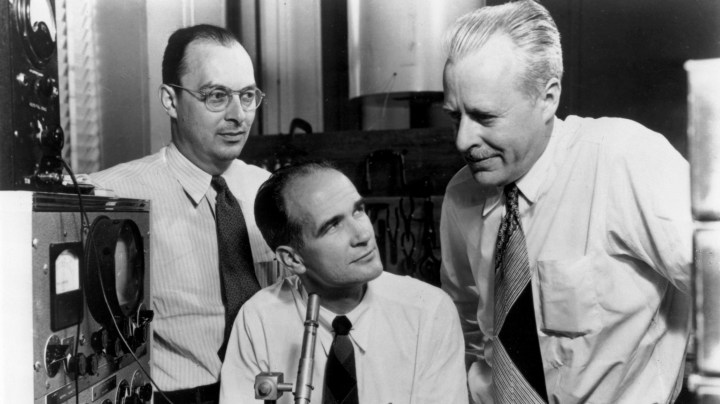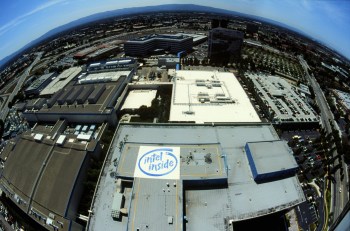
Bell Labs: The research center behind the transistor, and so much more
Bell Labs: The research center behind the transistor, and so much more

The future began 75 years ago this week with the invention of a device that’s seen as the most manufactured item in human history. The transistor was born in New Jersey on Dec. 16, 1947. This week, we’re looking at the ecosystems of innovation that turned that invention into … nearly everything.
The first transistor was a sort of crude metal spring pushing what looks like an arrowhead wrapped in gold foil down into a shard of germanium, the semiconductor, with all of that on top of a metal base.
On a campus 45 minutes west of Manhattan, in Murray Hill, New Jersey, researchers on the payroll of a private company figured out how to make an amplifier that didn’t need much power and an on/off switch with no moving parts. This fundamental invention gets us to portable and digital everything.

It was called Bell Telephone Laboratories, the research arm of AT&T. At its height, boy, did it have money – because it was a company with no rival.
“Bell Labs was kind of like a national laboratory in a way,” said physicist Michael Riordan, co-author of the history of the transistor, “Crystal Fire.”
“But it was funded by the American people. I’m old enough to remember when we had to pay $1 for the first minute of a coast-to-coast telephone call, called a toll call,” he said. “And three cents out of that dollar went into R&D, mainly at Bell Labs. So it had the stream of funding and gave them a lot of freedom to follow their research noses.”
“Being a lab that’s connected to a monopoly affords you certain privileges,” said Jon Gertner, author of “The Idea Factory: Bell Labs and the Great Age of American Innovation.”
“So the timelines are sort of different,” he said. “I mean, do you have to beat the competition to market? Not really. Can you work on a system for switching or transmission that might take 10 years or 15 years? Yes you can, actually.”
A hundred years ago, AT&T was the biggest company in the world and rich enough to scoop up talent even during lean times.

“Bell Labs had money to hire people in the Great Depression at a time when a lot of universities did not and a lot of companies did not,” Gertner said. “Brilliant scientists where Bell Labs could really hire the best and brightest.”
Like physicists John Bardeen, Walter Brattain, and William Shockley who shared a Nobel Prize for the transistor in 1956. Nine Nobel Prizes trace back to Bell Labs.
Ed Eckert, the archivist at today’s Bell Labs, can name a whole host of the world-changing discoveries and inventions through the years: “The cellular concept made cell phones practical, commercial fax machine, satellite pioneer with Telstar 1, solar cells, the science of radio astronomy and we discovered the leftover radiation that was considered proof of the Big Bang Theory.”

Bell Labs survived the court-ordered breakup of the AT&T monopoly in 1984 and some of its culture lives on. These days, this is one of the research centers owned since 2016 by Nokia of Finland. Peter Vetter is president of Nokia Bell Labs Core Research, where even today, there’s room for raw exploration.
“When a researcher comes to me, ‘Hi, I have here an intuition that there is a new way of solving the problem,’ they can go after that,” Vetter said. “And I say, ‘OK, this sounds good.’ We put them in contact with different experts — the device physics people, some AI algorithmic people — so that they can really enrich the idea.”

With wireless, about every 10 years it’s a new “G” and Vetter’s folks now are working on 6G. Plus, crazy-fast quantum computing. And, a new, not-so-small step for mankind, the first cellular network on the moon.

This is Nokia, but you may well ask why the Bell Labs transistor didn’t turn AT&T in the 1950s and ‘60s into another IBM or Sony? The reason: Even decades before AT&T’s breakup, officials in Washington didn’t want a monopoly phone company nosing into other businesses like computers.
“They were sort of bound by various agreements with the federal government that they were in the telecommunications business,” Gertner said.
So Bell Labs’ parent company more or less “open-sourced” the transistor. Not for free, but it sold licenses to other companies for not much and trained competitors in the theory. This allowed transistor technology to travel to Texas and California where the semiconductor revolution really takes hold.
There’s a lot happening in the world. Through it all, Marketplace is here for you.
You rely on Marketplace to break down the world’s events and tell you how it affects you in a fact-based, approachable way. We rely on your financial support to keep making that possible.
Your donation today powers the independent journalism that you rely on. For just $5/month, you can help sustain Marketplace so we can keep reporting on the things that matter to you.


















